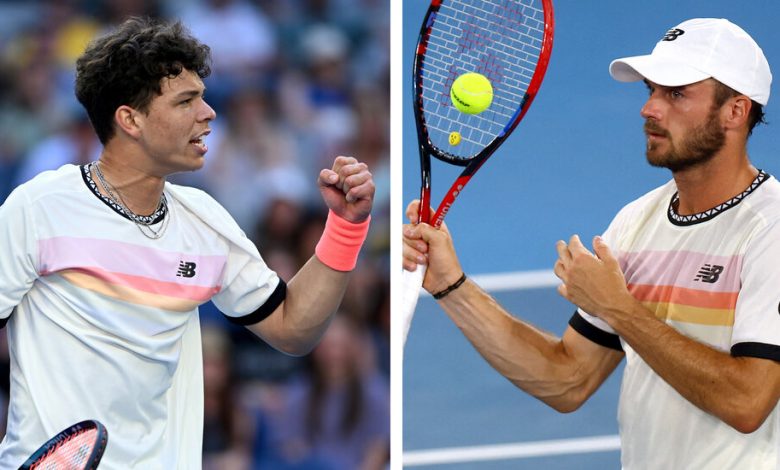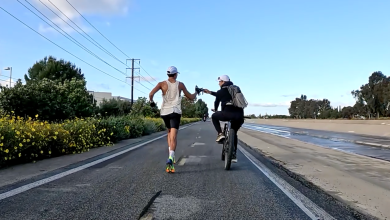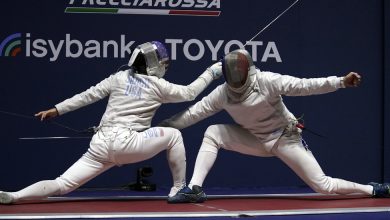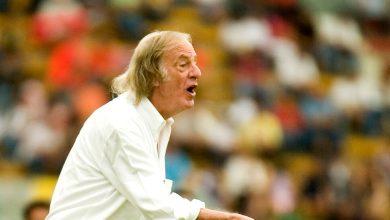An All-American Grand Slam Quarterfinal 16 Years in the Making

MELBOURNE, Australia — Maybe one day, and sooner rather than later, American men swimming in the deep end of the pool at Grand Slam tennis events will stop being noteworthy.
That is how it was during the first 40 years of the modern era of tennis, which began in 1968. During that era, some combination of players from the United States — Ashe, Smith, Connors, McEnroe, Agassi, Chang, Sampras, Courier, Roddick — almost always lurked, or even played each other, in the final days of the biggest tournaments.
Those days now feel so long ago, an era that was destined to end after the fall of the Iron Curtain, the spread of wealth to Eastern Europe and the growing popularity and accessibility of a previously inaccessible sport beyond its traditional power centers in the United States, Australia, Britain, France and a few other countries in Western Europe.
When Ben Shelton and Tommy Paul square off in the quarterfinals of the Australian Open on Wednesday afternoon (Tuesday night in the United States), it will be the first time two Americans have met this late in a Grand Slam event since Andy Roddick played Mardy Fish in Melbourne in 2007.
Since one of them has to win, the United States is guaranteed its first Australian Open semifinalist since Roddick in 2009. A third American quarterfinalist, Sebastian Korda, retired with a wrist injury, down, 7-6 (5), 6-3, 3-0, to Karen Khachanov of Russia. Korda could have made it two American Grand Slam semifinalists for the first time since 2005.
And yet, since early last summer, American men’s tennis has been having a moment that had been promised ever since the United States Tennis Association realized it had a serious problem on its hands some 15 years ago. This is what the U.S.T.A. had in mind when it began a development academy in 2008.
The program has changed since then, switching to an emphasis on periodic camps for promising young players rather than having them leave home as young teenagers. But the goal has always been to develop a critical mass of players to compete regularly at the most important tournaments. American women, led by Serena and Venus Williams, could always do it. Not so for the men. Then last summer, results began to show.
The 2023 Australian Open
The year’s first Grand Slam event runs from Jan. 16 to Jan. 29 in Melbourne.
- No Spotlight, No Problem: Jessica Pegula leads a cohort of players that few outside the locker room were paying attention to before the tournament. In this intensely mental sport, that was a good thing.
- Behind the Scenes: A coterie of billionaires, deep-pocketed companies and star players has engaged for months in a high-stakes battle to lead what they view as a once-in-a-generation opportunity to disrupt the sport.
- Endless Games: As matches stretch into the early-morning hours, players have grown concerned for their health and performance.
- A New Style Star: Frances Tiafoe may have lost his shot at winning the Australian Open, but his swirly “himbo” look won him fashion points.
“This is what we’ve been working for,” Martin Blackman, the general manager for player development at the U.S.T.A., said as he sat on a bench across from Centre Court at Wimbledon in July.
There, four American men made the final 16. Taylor Fritz barely lost to Rafael Nadal in a fifth-set tiebreaker in the quarterfinals. Two months later, at the U.S. Open, Frances Tiafoe became a sensation on his way to a semifinal loss to Carlos Alcaraz, the eventual champion and world No. 1.
Those tournaments were a little different though.
Wimbledon had barred Russians and Belarusians from participating because of Russia’s invasion of Ukraine. That took three dangerous opponents — Daniill Medvedev, Andrey Rublev and Khachanov — out of the draw.
At the 2022 U.S. Open, Tiafoe was the only American to make it to the fourth round. But his victory over Nadal and near-upset of Alcaraz, combined with Fritz’s title at Indian Wells, Calif., in March, produced a new level of confidence among a collection of players 25 and younger, several of whom have been traveling, training and playing together since their early teenage years.
“We expect to do well,” Paul, 25, said last week in an interview on a sun-splashed terrace in Melbourne as he watched another promising young American, Jenson Brooksby, beat Norway’s Casper Ruud, the second seed and a finalist at the French and U.S. Opens last year. “We probably expect to have at least a few of us in the second week. That’s our goal, and I know some of us want to go deeper.”
He also served what turned out to be notice that afternoon.
“We got Ben Shelton coming,” he said of the 20-year-old N.C.A.A. champion.
Paul has taken the young player under his wing since Shelton turned professional in the middle of last year.
“Kind of helped me navigate some of the early stages of a professional career,” Shelton said of Paul on Monday night, after his fourth-round win over another young American, J.J. Wolf, 24. “He’s been a good friend.”
A good friend but never an opponent. They have hit just once, warming up together in Ohio last summer. Paul’s plan ahead of the quarterfinal was to watch videos of Shelton’s matches. What he will see is a dangerous lefty, seemingly fearless beyond his years, with a thumping serve and a fast-improving power game from the baseline.
Shelton is still taking classes at the University of Florida and is determined to get his degree. He said he was lucky the semester had just started, so balancing school work with preparing for his matches was not a problem.
Shelton also had the good fortune of a kind draw. Ranked 89th in the world at the beginning of the tournament, he has yet to face a seeded player. Most of his opponents have been lower ranked. One received a wild card. Another survived the qualifying tournament.
Paul, ranked 35th, peaked at 29th in the world last year. He won the French Open boys’ singles title in 2015. Since then, though, he and his close friends and countrymen — Tiafoe, Fritz and Reilly Opelka — have watched players they beat as juniors achieve more than they have. But he believed he would play in the late stages of a Grand Slam event, even if, as he put it, some people might have considered him somewhat delusional in recent years.
Born in New Jersey and raised in North Carolina, where he grew up playing on clay courts in Greenville, N.C., Paul is an all-court player with quick feet. He also has a frightening serve that topped out at 137 miles per hour during his fourth-round win over Roberto Bautista Agut of Spain. The ball off his racket sounds like wood popping in a campfire.
Between points, and even in his service motion, there is a languid quality to his movements. Then the point begins and, if he is on, Paul is all grit, touch and force. But he is also comfortable banging and scrambling as long as the point requires.
Lately, he has been playing with a freakish display of calm that betrays none of his internal tension. It’s the aspect of his game that he has worked on the hardest over the past 18 months.
“That’s the hard part of playing tennis, right?” he said. “You got to keep calm.”
That is especially true during five-set matches in Grand Slam events that include plenty of peaks and valleys, both physical and mental. Shelton, whose father, Bryan, played on the ATP Tour in the 1990s and now coaches both his son and the men’s team at Florida, has endured some early lessons in that. Two of his four matches have gone the distance. One ended in a fifth-set tiebreaker.
For Paul and Shelton, doing Tiafoe one better and becoming the first American man to make a Grand Slam final since Roddick lost to Roger Federer at Wimbledon in 2009, still may be too high a mountain to climb. The winner gets a likely semifinal match with Novak Djokovic, the nine-time Australian Open champion with 21 Grand Slam titles who is rounding into form as the tournament wears on.
Paul would relish that chance anyway. He has waited a long time for it, and so has his country.




